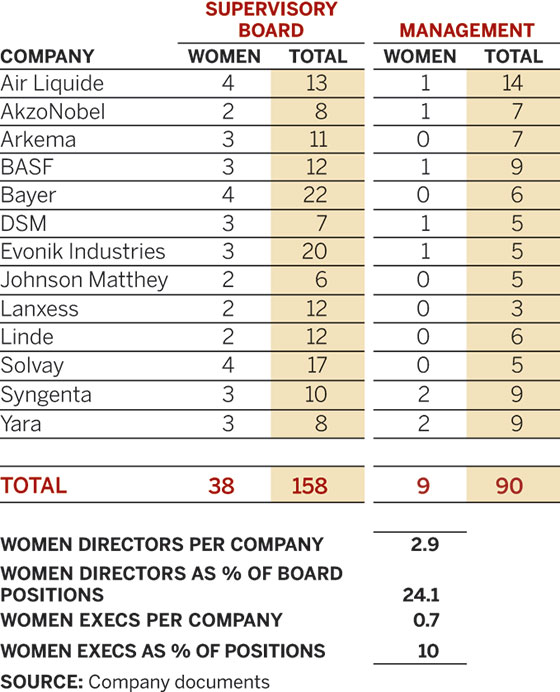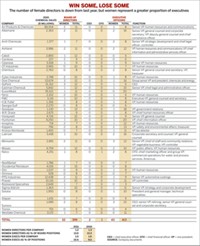Advertisement
Grab your lab coat. Let's get started
Welcome!
Welcome!
Create an account below to get 6 C&EN articles per month, receive newsletters and more - all free.
It seems this is your first time logging in online. Please enter the following information to continue.
As an ACS member you automatically get access to this site. All we need is few more details to create your reading experience.
Not you? Sign in with a different account.
Not you? Sign in with a different account.
ERROR 1
ERROR 1
ERROR 2
ERROR 2
ERROR 2
ERROR 2
ERROR 2
Password and Confirm password must match.
If you have an ACS member number, please enter it here so we can link this account to your membership. (optional)
ERROR 2
ACS values your privacy. By submitting your information, you are gaining access to C&EN and subscribing to our weekly newsletter. We use the information you provide to make your reading experience better, and we will never sell your data to third party members.
Business
Women in Industry
Results in 2005 show that women gained some ground in management, but not on the board
by Alexander H. Tullo, C&EN Northeast News Bureau
June 13, 2005
| A version of this story appeared in
Volume 83, Issue 24
C &EN’s annual survey of women serving on the boards of directors and as executive officers of 42 public U.S. chemical companies is showing mixed results this year. Although chemical companies are fielding more female chemical executives than a year ago, representation of women on boards of directors remains stagnant.
Some 50 of the 407 directors surveyed are women. This 12.3% share of the positions is unchanged from a year ago. The number of women directors per company has also held steady at 1.2.
Figures for the boards of directors crested in the 2003 survey, when women held 12.8% of the positions and there were 1.3 female directors per company.
This year, there is even an inside director—a director who is also an employee of the company: Westlake Chemical Senior Vice President and Chief Financial Officer Ruth I. Dreessen, who used to be a director of Georgia Gulf Corp.
This year, out of the 430 executive officers surveyed at the 42 chemical companies, 34 are women. This 7.9% turnout represents a sharp gain over the 6.3% found in last year’s survey. Also, the 0.8 executive officers per company is also an improvement over the 0.6 of a year ago.
For the first time in a long time, there were entries other than zeros in the position of chief financial officer. Westlake’s Dreessen holds one of the positions. The other is Karen R. Osar, executive vice president and CFO at Crompton Corp. In the executive officer and chief operating officer categories, there are, again, nothing but goose eggs.
Information from the C&EN survey is taken from annual reports, 10-K filings with the Securities & Exchange Commission (SEC), and proxy statements to determine who was serving as an executive officer or on the board of directors at the beginning of 2005.
The frenzy of deal-making in the chemical industry this year has forced C&EN to make many amendments in the companies that are surveyed. Westlake Chemical replaces Millennium Chemicals, which was acquired by Lyondell Chemical. Likewise, Mississippi Chemical has been purchased by Terra Industries. Because of these changes, last year’s results have been revised to include two comparable years of both Terra and Westlake.
Similarly, Kronos has been spun off from NL Industries, and NewMarket Corp. is the new name for Ethyl Corp. Mosaic is the result of the merger of IMC Global and Cargill’s fertilizer business. In these cases, the results for the predecessor companies have been used for the previous years. Mosaic’s information was taken from its registration statement with SEC because it has yet to file its first 10-K report.
Ferro Corp. is restating prior-year results and thus is late with its 10-K filing. Its information was taken from other company documents.
The C&EN survey is inspired by surveys of Fortune 500 companies conducted by Catalyst, a group that promotes women’s leadership in business. In its most recent survey of women corporate officers, published in 2002, Catalyst found that women held 15.7% of corporate officer positions. This figure is higher than C&EN’s because it includes all vice presidents and other corporate officers of every given company. C&EN uses the smaller executive officer category because it provides a consistent standard. In 2003, Catalyst found that women made up 13.6% of corporate board seats.
Nor is Catalyst’s the only such survey. The Chartered Management Institute surveyed British companies last year and found that 14.3% of directors were women, an improvement from less than 10% only five years ago. It also found that one in three managers were women.
The Chartered Management survey also found that women managers at chemical companies earn more than their counterparts in the information technology, governmental, and financial sectors and that women out-earn men in R&D positions.
C&EN’s methodology doesn’t capture all of the chemical industry’s high-profile female executives, such as Fran Keeth, president and CEO of Shell Chemical LP; Kathleen M. Bader, president and CEO of Cargill’s polylactic acid business, NatureWorks; and Stephanie A. Burns, president and CEO of Dow Corning.
Also not counted is Ellen J. Kullman, vice president of DuPont Safety & Protection, who is not an executive officer this year but who was named the first female DuPont vice president in 1995. In February, she gave a speech to female leaders at DuPont’s European headquarters in Geneva, Switzerland, on work/life balance. “The best teams win when their members are all at their highest form,” she said.
Catalyst advocates for changes in the balance of work and private life for both men and women, with the hope that more corporate flexibility will assist women. Lisa Levey, director of advisory services at Catalyst, says companies ought to move away from the notion that working long hours is productive. She says research suggests it isn’t necessarily the case. She is critical of the overabundance of meetings, travel, and superfluous communication in the workplace. “There continues to be a bias of the more, the better,” she notes.
Levey adds that while the work/life balance issue was fashionable in the late 1990s, it fell out of favor with the recent economic slowdown. Companies fell back to old models as they laid people off. She says, however, that companies are again getting back on track on these issues.
Such an evolutionary approach is hoped to eventually boost the number of women in top management. This is a far cry from the methods employed in Norway, which in 2002 mandated that companies have 40% representation of women on their corporate boards by 2005. The result is an increase to 11% board representation this year from 6% in 2002, according to published reports—an improvement, but far short of the government’s mandate. Mostly, state companies like Statoil made the grade. Now, the government is threatening to shut down companies that don’t comply.
Although U.S. chemical companies, without being forced, are in better shape than Norwegian firms, participation by women in the top tiers of the chemical industry is still below what most advocates would like to see.
MORE ON THIS STORY
TABLE 1 - MOVING FORWARD
Women posted solid gains in top executive positions at chemical companies







Join the conversation
Contact the reporter
Submit a Letter to the Editor for publication
Engage with us on Twitter